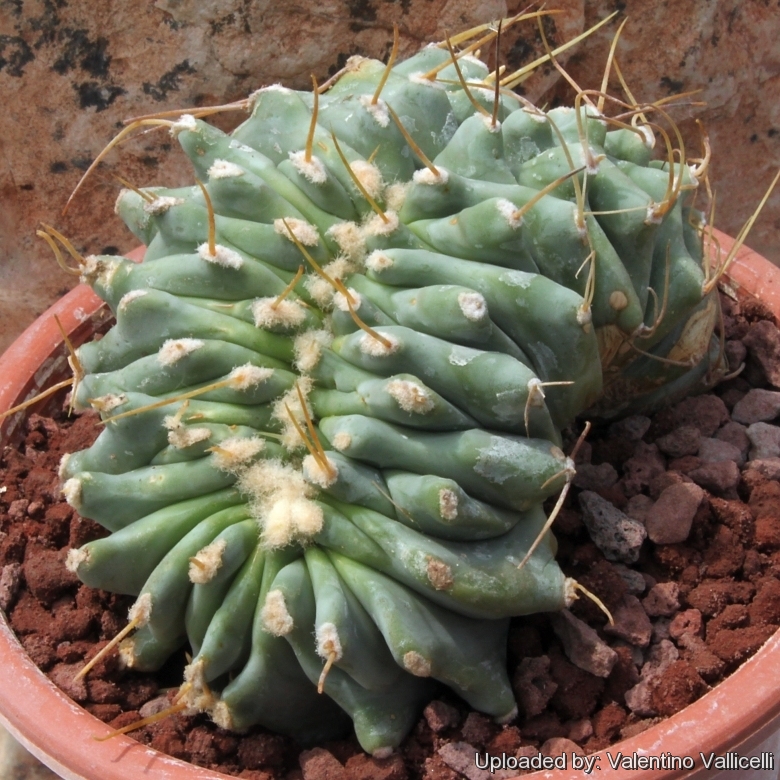Accepted Scientific Name: Ferocactus glaucescens
Cactaceae (Britton & Rose) 3: 137. 1922

Ferocactus glaucescens f. nudus cristatus Photo by: Valentino Vallicelli
Origin and Habitat: Garden origin (Nursery produced). The wild species occurs over a considerable range from Guanajuato to Querétaro, San Luis Potosí and Hidalgo (Meztitlan, Toliman and Jacala) in Eastern central Mexico.
Synonyms:
See all synonyms of Ferocactus glaucescens
back
Accepted name in llifle Database:Ferocactus glaucescens (DC.) Britton & RoseCactaceae (Britton & Rose) 3: 137. 1922Synonymy: 13
Cultivars
(1):
back
Description: Ferocactus glaucescensSN|1532]]SN|1532]] f. nudus is the nice spineless form of the blue stemmed Ferocactus glaucescensSN|1532]]SN|1532]]. This cultivar varies from pure nude specimens to plants with one or few spine per areoles (Partially nudum), but usually the spines completely disappear in mature stems. The crested form Ferocactus glaucescensSN|1532]]SN|1532]] f. nudus cristatus - despite to its beauty - is still very rare and sought after by collectors, for its unique features.
Stem: Fan shaped, flattened on top, depressed centrally along the line meristem, glaucous grey.
Ribs: Prominent, acute, slightly tuberculate and expanded under areoles, 2 cm high.
Areoles: Greyish-white felted, young areoles circular, becoming elongate in mature flowering plants up to 15 mm long, constricted between the flower and the spine-bearing section, 2-3 cm apart or even less in old plants.
Spines: Absent or very few (1 to 3 not distinguishable from radials to centrals) irregularly scattered on the areoles of young individuals.
Flowers: Lemon yellow, funnel-shaped, 3-4 cm in diameter. The tepals are oblong, lanceolate, silky, shining; the margins are finely fringed. Stamen, style and stigma are yellow. Stigma lobes: 12-15.
Blooming season: Late spring and summer. The flowers last a very long time. The plants start flowering when about 13 cm in diameter.
Fruits: White, 2 cm long with the remnants of the flowers attached.
Subspecies, varieties, forms and cultivars of plants belonging to the Ferocactus pottsii complex
(This Taxon belong to a group of six closely allied species. The group is: Ferocactus alamosanus, Ferocactus schwarzii, Ferocactus reppenhagenii, Ferocactus glaucescens, & Ferocactus echidne)
Bibliography: Major references and further lectures
1) Edward Anderson “The Cactus family” Timber Press, Incorporated, 2001
2) James Cullen, Sabina G. Knees, H. Suzanne Cubey "The European Garden Flora Flowering Plants: A Manual for the Identification of Plants Cultivated in Europe, Both Out-of-Doors and Under Glass" Cambridge University Press, 11/Aug/2011
3) David R Hunt; Nigel P Taylor; Graham Charles; International Cactaceae Systematics Group. "The New Cactus Lexicon" dh books, 2006
4) N. L. Britton, J. N. Rose “The Cactaceae. Descriptions and Illustrations of Plants of the Cactus Family.” Volume 4, The Carnegie Institution of Washington, Washington 1923
Cultivation and Propagation: It is not too difficult in a greenhouse, although grows quite slowly. It is usually seen as a grafted plant but can grow on its own roots too.
Soil: Use a mineral well permeable soil with little organic matter (peat, humus).
Exposure: They need a good amount of light shade to full sun this help to keep the plants healthy, although slow growth.
Watering: Water sparingly from March till October (weekly during summertime, if the weather is sunny enough), with a little fertilizer added. Less or no water during cold winter months, or when night temperatures remain below 10° to prevent root loss. It is sensitive to overwatering (rot prone).
Fertilization: Feeding may not be necessary at all if the compost is fresh then, feed in summer only if the plant hasn't been repotted recently. Do not feed the plants from September onwards as this can cause lush growth which can be fatal during the darker cold months.
Hardiness: Keep perfectly dry in winter at temperatures from 5 to 15 degrees centigrade. (but it is relatively cold resistant and hardy to -5° C, or possibly colder for short periods) In the rest period no high atmospheric humidity!! (Temperature Zone: USDA 9-11)
Crested growth: Unlike 'monstrose' varieties of plants, where the variation from normal growth is due to genetic mutation, crested growth can occur on normal plants. Sometimes it's due to variances in light intensity, or damage, but generally the causes are unknown. A crested plant may have some areas growing normally, and a cresting plant that looks like a brain, may revert to normal growth for no apparent reason. If you have any of the crested part left you need to remove the normal growth and leave the crested part behind this will need to be done regularly.
Propagation: Grafting or cuttings. Plants are usually grafted onto column-shaped cacti but proved to be able to produce their own roots if degrafted. Cuttings will take root in a minimum temperature of 20° C (but better in hot weather). Cuttings of healthy shoots can be taken in the spring and summer. Cut the stem with a sharp, sterile knife, leave the cutting in a warm, dry place for a week or weeks (depending on how thick the cutting is) until a callus forms over the wound. Once the callus forms, the cutting may be inserted in a container filled with firmed cactus potting mix topped with a surface layer of coarse grit. They should be placed in the coarse grit only; this prevents the cut end from becoming too wet and allows the roots to penetrate the rich compost underneath. The cuttings should root in 2 to 6 weeks. Large crested piece must be placed on the soil surface without burying the plant base down in the soil.










